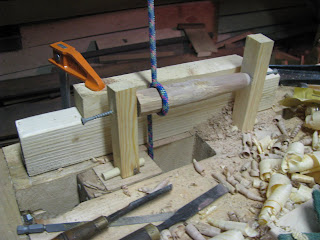To begin I drilled a series of small holes where the mouth will be. Then I connected them with a fret saw, and filed them flat. It is essential to leave the mouth too small, this can be opened up later. The bed angle needs to be worked into the back of the mouth opening. I made a ramp with the same incline as the bed angle, and used that to guide my chisel to make the cut. Leave the entire sole oversize, that can be trimmed down later. The sole is glued onto the body (after the surfaces have been smoothed and flattened) using epoxy. It is very important to align the parts accurately. I drove really small nails into the plane body, and clipped the heads so the protruded out about 1/16". This reduces the amount the sole will shift while being glued. Let the epoxy set according on what open time the package says. I didn't, I un-clamped it too soon, and the epoxy failed. So I had to re-glue the corner that came off.
The wedge is a nice looking design, but a hassle to make. It is at 10 degrees, to match the other angles. I sawed the angle out, and used my float (carefully!) to smooth the mating edges. With this done, I shaped the top portion using chisels, my float, and sandpaper. After the wedge, the plane is essentially done, I shaped the sides into a coffin shape, with a block plane and finished up with sand paper. To ensure crispness of all the details, I sanded first, and then cut the long chamfers with a spokeshave, and the short chamfers with my float. I flattened the sole of the plane with sandpaper and gave it two coats of oil.


Now onto the fettling. I was having problems with shavings just bunching up, and not being fluffy and nice.
 I opened up the throat area, removing any material that might have caused bunching, and tried it again. Definite improvement. Then I tried opening the mouth slightly and bingo! Nice easy planing.
I opened up the throat area, removing any material that might have caused bunching, and tried it again. Definite improvement. Then I tried opening the mouth slightly and bingo! Nice easy planing. 
 Here is a group shop, so you can see its size.
Here is a group shop, so you can see its size. 
 It's really small. I can't tell a really big difference between this plane's resultant surface and my Stanley #4's, but it is a handy size, and works pretty well. One thing I don't like is the weight. I have to press pretty hard down onto it in order to get a good cut. But for a first wooden plane, not so bad!
It's really small. I can't tell a really big difference between this plane's resultant surface and my Stanley #4's, but it is a handy size, and works pretty well. One thing I don't like is the weight. I have to press pretty hard down onto it in order to get a good cut. But for a first wooden plane, not so bad!




















